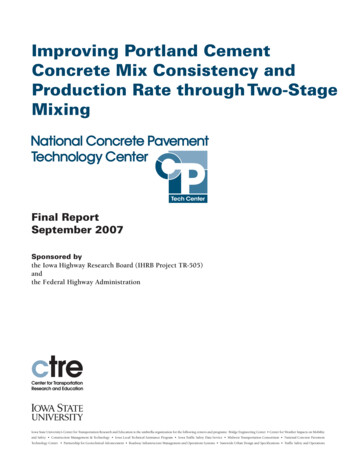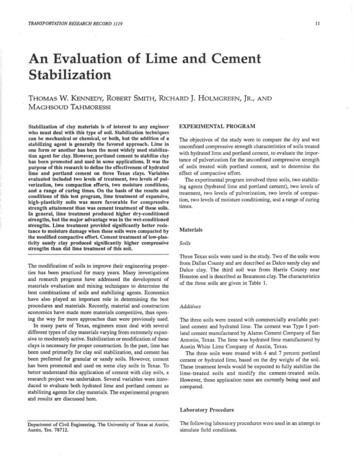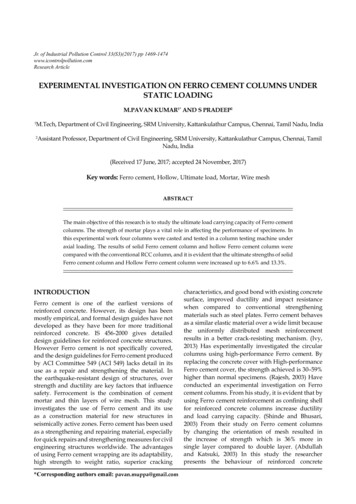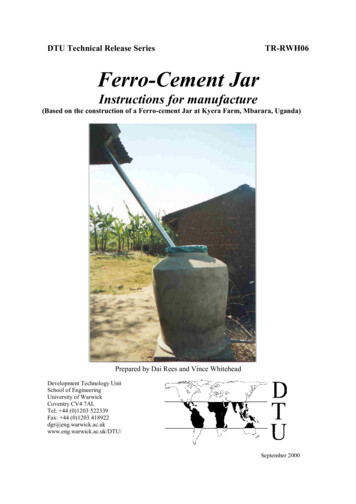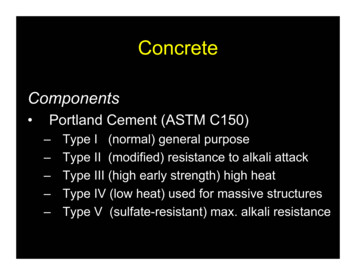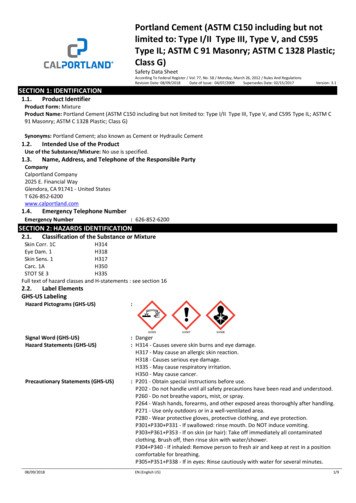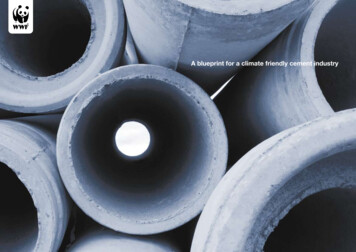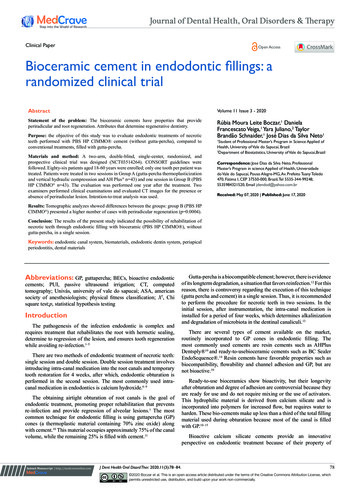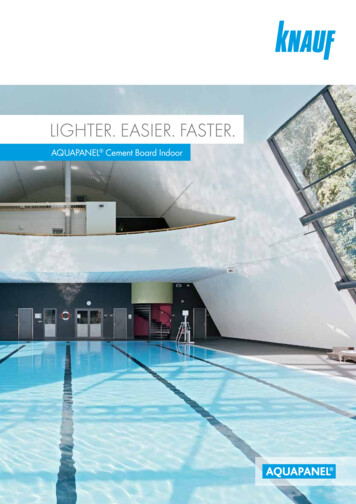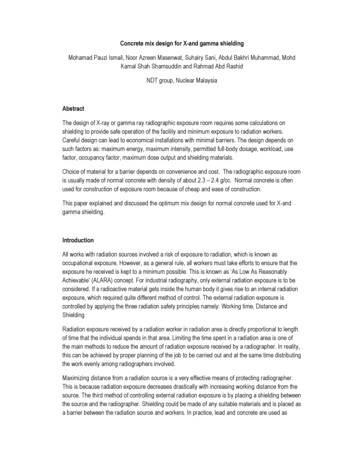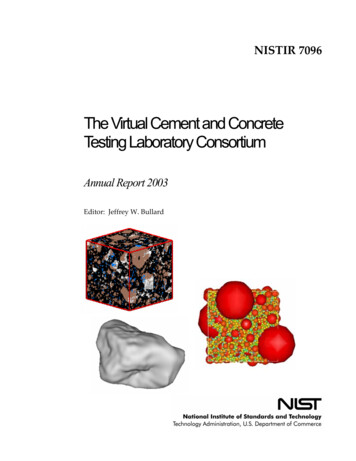
Transcription
NISTIR 7096The Virtual Cement and ConcreteTesting Laboratory ConsortiumAnnual Report 2003Editor: Jeffrey W. Bullard
NISTIR 7096The Virtual Cement andConcrete Testing LaboratoryConsortiumAnnual Report 2003Editor: Jeffrey W. BullardBuilding and Fire Research LaboratoryJanuary 2003U.S. DEPARTMENT OF COMMERCEDonald L. Evans, SecretaryTECHNOLOGY ADMINISTRATIONPhillip J. Bond, Under Secretary of Commerce for Technology
ContentsContents.1Virtual Cement and Concrete Testing Laboratory Consortium .3VCCTL Publications .6VCCTL Publicity.8VCCTL Consortium Members.10Materials Characterization.11Hydration Research.16Rheological Properties .20Mechanical Properties .27Durability Research.31Case Study I.34Case Study II.36Case Study III.39NIST/Industry VCCTL Funding .42NIST Equipment and Facilities.42For More Information .47i
DISCLAIMERCertain trade names or company products are mentioned in the text to specifyadequately the experimental procedure and equipment used. In no case does suchidentification imply recommendation or endorsement by the National Institute ofStandards and Technology, nor does it imply that the equipment is the bestavailable for the purpose.2
Virtual Cement and ConcreteTesting Laboratory ConsortiumAnnual Report 2003BackgroundThe Virtual Cement and Concrete Testing Laboratory (VCCTL) Consortium wasformed in January 2001. Headquartered in the Building and Fire ResearchLaboratory (BFRL) at the National Institute of Standards and Technology (NIST),the consortium originally consisted of three NIST laboratories: BFRL, theInformation Technology Laboratory (ITL), and the Materials Science andEngineering Laboratory (MSEL), and six industrial members: Cemex TrademarksWorldwide, Ltd., Dyckerhoff AG, Holcim (US) Inc., Master Builders TechnologiesInc. (MBT), the Portland Cement Association (PCA), and W.R. Grace & Co. Theoverall goals of the consortium were—and continue to be—to develop a virtualtesting system that will reduce the amount of physical concrete testing needed andexpedite the research and development process. This will result in substantial timeand cost savings to the concrete construction industry as a whole.The VCCTL Consortium Oversight Board, consisting of one representative fromeach member organization and the VCCTL Consortium Manager from NIST,governs the activities and direction of the consortium. The oversight board meetstwice each year to review research progress and set the scope and agenda of futureresearch. Within each industrial participant’s laboratory, one researcher is assignedto participate in the research programs of the consortium. Once each year, the mostrecent version of the VCCTL system software is installed on a desktop computer ateach participating member’s laboratory.The ultimate goal of the consortium is to address durability and service lifeprediction, but the members recognized that first efforts must be concentratedtowards enhancing the current microstructure models and property calculations.Therefore, the three major initial research topics of the consortium were: 1)enhancements to the cement hydration and microstructure development model toconsider additional supplementary materials such as slags and limestones and theprediction of pore solution concentrations, 2) computation of the elastic properties(elastic modulus, creep, shrinkage) of three-dimensional microstructures, and 3)experimental measurement and computer modeling of the rheological properties(viscosity, yield stress) of cement-based materials.3
This document reports the activities of the VCCTL Consortium in 2003.Overview of Activities in 2003The 2003 calendar year represents the third and final year (hereafter called Year 3)of the initial three-year consortium term. At the start of Year 3, the consortium wascomprised of eight industry members: Cemex Trademarks Worldwide, Ltd.,Dyckerhoff AG, Holcim (US) Inc., the International Center for AggregatesResearch (ICAR), the Portland Cement Association (PCA), Sika Technology AG,Verein Deutscher Zementwerke eV(VDZ), and W.R. Grace & Co. During Year 3,three new members were welcomed into the consortium: Association Technique de l’Industrie des Liants Hydrauliques (ATILH), Paris,FRANCE National Ready Mixed Concrete Association (NRMCA), Silver Spring,Maryland, USA (as of January 2004) Master Builder Technologies (MBT), Cleveland, Ohio, USA (as of January 2004).The VCCTL Consortium continues to represent every major constituent ofconcrete—cement, aggregate, and chemical admixtures, the major manufacturers ofconcrete, and major research and service organizations.One of our charter industry partners, Dyckerhoff AG, made major changes in itsresearch focus and personnel in 2003. One of these changes was to discontinueparticipation in the VCCTL Consortium. Dyckerhoff had been one of the mostactive research participants throughout the first three years of the consortium. TheirVCCTL representative, Dr. Claus-Jochen Häcker, contributed several key researchadvances, including modifying the dissolution behavior of sulfates in CEMHYD3Dand the experimental measurement of elastic properties of cement paste phases.Dyckerhoff’s participation and perspectives will be missed by the consortium.Year 3 witnessed a number of important research advances in each of the VCCTL’smajor focus areas. These advances are summarized in the following table.MaterialsCharacterizationDirect measurement of gypsum PSD in cement powder;tomographic analysis of aggregates from 19 sources,characterization of cement particle shapesHydrationIncorporation of real cement particle shapes, integrationof actual cement PSD into models; calculation of onepixel particle bias; improvements in fly ash reactionkineticsElasticityValidation of effective medium theory for mortar andconcrete elastic moduli predictions; exploration ofcompressive strength predictions from elastic moduli4
RheologyA simulation of a parallel plate rheometer wasdeveloped; and interparticle interaction potentials wereintroduced in the DPD modelDurabilityThree models were made available through the NISTwebsite; progress was made in development of anaccelerated test for determining the sulfate resistance ofa cement.As in previous years [1,2], most of this progress was made possible only bycollaborative efforts between NIST and the industry partners, a fact thatdemonstrates once again how critical the consortium arrangement has been toaccelerating research.Further enhancements also were made in Year 3 to the web-based VCCTL interface,augmenting the major changes made in Year 2. Among these are the ability tosearch online for desired files needed as input in the user forms, added flexibility inthe specification of microstructure parameters in CEMHYD3D, and links tocommon next steps at the bottom of most forms to make navigation of the formseasier.References[1] “The Virtual Cement and Concrete Testing Laboratory Consortium AnnualReport 2002,” NISTIR 6962, U.S. Department of Commerce. Edited by J.W. Bullard,January 2003.[2] “The Virtual Cement and Concrete Testing Laboratory Consortium AnnualReport 2001,” NISTIR 6840, U.S. Department of Commerce. Edited by D.P. Bentz,December 2001.5
VCCTL PublicationsTechnical Notes Technical Note VCCTL-01: Estimation of the Degree of Hydration of PortlandCement by Determination of the Non-Evaporable Water Content Technical Note VCCTL-02: SEM/X-ray Imaging of Cement Powders Technical Note VCCTL-03: Quantitative Determination of CalciumsulfateDihydrate and Calciumsulfate Hemihydrate in Cement by Means ofThermogravimetric Analysis (from Dyckerhoff) Technical Note VCCTL-04: Estimation of the Degree of Hydration of Cementby Measurement of Chemical Shrinkage Technical Note VCCTL-05: Rheological measurement of cement paste/mortarusing a parallel plate rheometer Technical Note VCCTL-06: Standard Method for Measuring the Particle SizeDistribution of Hydraulic Cement and Related Compounds by Light Scattering Technical Note VCCTL-07: Wet/Dry Cycling Method for DeterminingResistance to Sulfate Attack (due in 2004) Technical Note VCCTL-08: Pore solution extractor (due in 2004)Software Notes Software Note VCCTL-01: CONCRETEVIEW software Software Note VCCTL-02: Software for Hydration/Drying of 2-mm ThickMicrostructures Software Note VCCTL-03: Computation of Cement Paste Elastic Properties Software Note VCCTL-04: Software for the Degradation of HydratedMicrostructures Due to Magnesium Sulfate Attack6
Manuals D.P. Bentz and G.P. Forney, “User’s Guide to the NIST Virtual Cement andConcrete Testing Laboratory. Version 1.0”. NISTIR 6583. U.S. Department ofCommerce, November 2000. J.W. Bullard, “User’s Guide to the NIST Virtual Cement and Concrete TestingLaboratory. Version 3.0”. Distributed to consortium members as part of theVCCTL Version 3.0 software distribution. J.W. Bullard, “User’s Guide to the NIST Virtual Cement and Concrete TestingLaboratory. Version 1.1”. NISTIR 6984. U.S. Department of Commerce, March2003.Reports “The Virtual Cement and Concrete Testing Laboratory Consortium AnnualReport 2001”. Edited by D.P. Bentz. NISTIR 6840. U.S. Department ofCommerce, December 2001. “The Virtual Cement and Concrete Testing Laboratory Consortium AnnualReport 2002”. Edited by J.W. Bullard. NISTIR 6962. U.S. Department ofCommerce, January 2003.7
VCCTL PublicityNEW 2003E.J. Garboczi, “The Virtual Cement and Concrete Testing Laboratory—Progress Report and ASTM Relevance.” Presentation to ASTM CommitteesC01 and C09, Tampa, FL. (December 10, 2003).NEW 2003J.W. Bullard, et al., “Virtual Cement and Concrete”. Chapter 10 in Innovationsin Portland Cement Manufacture. Edited by J. Bhatty and S. Kosmatka. PortlandCement Association, in press.NEW 2003R.C. Meininger, “Virtual Aggregates,” Rock Products. October 1, 2003.Available online at http://rockproducts.com/ar/rock virtual aggregates/NEW 2003“NRMCA Participates in Development of Virtual Concrete Testing Lab.”NRMCA E-NEWS. November 24, 2003.NEW 2003“Virtual Cement and Concrete—The Coming Revolution in ConcreteTechnology.” Special symposium held at the ACI Spring 2003 Convention,Vancouver, Canada. April 1, 2003. Presentation to the ACI Strategic Development Council as part of the NewTechnology Showcase, Orlando, FL (November 18, 2002). “VCCTL: A WebBased Virtual Cement and Concrete Testing Laboratory.” Special presentation by E.J. Garboczi to the Research Committee of the NationalReady-Mixed Concrete Association, Arlington, VA (October 6, 2002). “VCCTL:A Web-Based Virtual Cement and Concrete Testing Laboratory Special 90-minute presentation by J.W. Bullard and E.J. Garboczi at the PortlandCement Association meeting, Chicago, IL (September 16, 2002). “VCCTL: AWeb-Based Virtual Cement and Concrete Testing Laboratory.” Daily Commercial News and Construction Record (September 13, 2002).“Facility Provides Virtual Testing for Concrete.” Special symposium organized by G.J. Frohnsdorff and C. Ferraris, presented toASTM Committees C-01 and C-09, Salt Lake City, UT (June 26, 2002). “TheVirtual Cement and Concrete Testing Laboratory.” Concrete Construction (November, 2001). “Virtual Concrete Laboratory”8
The Concrete Producer (October, 2001). “E-Concrete: Let's Try a Little LeftThinking” Government Computer News (August 27, 2001). “NIST Team Sees in Stereo”(available at http://www.gcn.com/20 25/news/16941-1.html) Engineering News Record (June 25, 2001). “Website Aims to Cut ConcreteAnalysis” (available at http://www.enr.com/itnews/it62501e.asp ) Civil Engineering (June, 2001). “Virtual Concrete Lab Saves Time, ReducesMaterial Cost” NIST Technology at a Glance (Spring, 2001). “Co-Op Corner, Virtual CementLaboratory” NIST Update (February 20, 2001). “Virtual Lab Consortium to Test Concreteand Cement Formulas” Concrete Technology Today- PCA (December, 2000). “ The Future of MaterialsTesting? Virtual Testing of Concrete Will Save Time and Money”VCCTL Newsletter. In Year 2, NIST began publishing a VCCTL Newsletter, which isdistributed to members of the VCCTL Consortium and to users who login to thepublic domain site for the VCCTL software (Version 1.1). The newsletter highlightsapplications by users of the public domain version and also gives periodic tips forusing the software. The VCCTL Newsletter is intended as a source of usefulinformation as well as a publicity tool for the consortium.9
VCCTL Consortium MembersNISTHolcim (US) Inc.Dr. Jeffrey W. Bullard (BFRL)Mr. Barry DescheneauxDr. Judith Devaney (ITL)Mr. Al InnisDr. Chiara F. Ferraris (BFRL)Dr. Edward J. Garboczi (BFRL)Mr. John Hagedorn (ITL)Portland Cement AssociationDr. Paul TennisMr. Peter Ketcham (ITL)Dr. Nicos S. Martys (BFRL)W.R. Grace & Co.- Conn.Mr. Steve Satterfield (ITL)Dr. Vijay GuptaMr. Paul Stutzman (BFRL)Dr. David MyersCemex Trademarks Worldwide, LtdMs. Karen OrnelasDyckerhoff AGDr. Claus-Jochen HäckerMr. Javier VazquezDr. Davide ZampiniVerein Deutscher Zementwerke eV (VDZ)Dr. Martin SchneiderDr. Georg LocherDr. Maria Teresa AlonsoSika Technology AGDr. Robert FlattAssociation Technique de l’Industrie desLiants Hydrauliques (ATILH)Dr. Alain CapmasProf. Denis Damidot (Mines de Douai)International Center for Aggregates Research(ICAR)Prof. David W. Fowler (U. Texas at Austin)10
Materials CharacterizationThe properties of materials depend upon their internal structure. In turn, theproperties influence the performance of a material, both during manufactureand in ultimate service [1].BackgroundWithout meticulous characterization of the starting materials, it is practicallyimpossible to formulate fundamental microstructure models of the hydration andproperties of a cement paste, mortar, or concrete. One of the signature features andstrengths of the CEMHYD3D hydration model is its incorporation ofmicrostructural information with unprecedented levels of detail.Proper characterization of cement-based materials is not a trivial task. The startingpowders typically consist of a wide distribution of particle sizes, each particle ofwhich is composed of multiple phases with variable chemical compositions. Manyproducts of hydration are amorphous or poorly crystalline, and these may be finelyintermixed. An additional complication is that some microstructural characteristicshave not been rigorously defined. In some cases it has not been possible even toproperly calibrate measurements, like those of particle size distribution (PSD),because of the absence of an accepted reference material or standard methodology.Recognizing the critical importance of materials characterization for predictions ofmicrostructure development, physical properties, and durability, the consortiumhas continually sought to achieve greater accuracy and detail in these types ofmeasurements, and to supply robust, calibrated measurement techniques wherethose have been lacking.Activities in Years 1 and 2Particle Size Distribution. In collaboration with ASTM Subcommittee C01.25, itwas established that there was no standard test for measuring the PSDs of cementsand no reference material existed. NIST was instrumental in 1) analyzing the datathat were already available from a round-robin conducted by ASTM [2] and 2)organizing a second, more extensive, round-robin and analyzing the data [3]. Themain result was to establish that: 1) the most used method by the cement industry isthe laser diffraction technology; 2) the particle size distribution of the standardreference material (SRM), cement SRM 114p, was established and now is included inthe certificate provided by NIST with the material; 3) the basis of a standardprocedure was developed. Therefore, now the industry has a reference material thatcan be used to calibrate an instrument or to validate the laser diffraction procedureused in a laboratory.11
The efficacy of calcium sulfate in Portland cement, for controlling C3A hydrationand microstructure development, has been demonstrated to depend on its spatialdistribution and specific surface area [4]. Because both of these factors are expectedto depend on the PSD of the calcium sulfate component, research was initiated inYear 2 to find and validate techniques for measuring the PSD of calcium sulfateafter it has been blended/interground with clinker. By the end of Year 2, a novelapproach using the wet laser diffraction technique had been identified. Moredetails on the technique and its validation are given in the next section.SEM/X-ray Imaging. NIST has pioneered the use of SEM/X-ray imaging for thequantitative characterization of cement powders [5]. This analysis produces a 2-Dimage of the cement powder in which each pixel is identified as one of the majorphases of portland cement.Research in Year 3Particle Size Distribution. To pursue further the goal of providing industry with amethod to measure the PSD of cement, two actions were pursued in year 3. The firstone is related to the SRM 114p cement, whose stocks are fast diminishing. Therefore,NIST initiated a procedure to produce the next generation SRM, SRM 114Q. Thisprocedure includes the purchase of a large stock of cement, the homogeneisation of thematerial, the production of 100 000 vials in sealed containers, and the characterization ofthe material by a round-robin. This process is expected to be completed in 2004. NISTdeveloped a standard procedure that was provided to the members as Technical Note#6. This standard was presented to ASTM subcommittee C01.25 and to the Task Groupon PSD but was rejected because the Task Group wants to develop a standard thatincludes all possible methods, i.e., SEM, EZS, sieving, and sedimentation. The TaskGroup wants to use the SRM 114 curves developed for laser diffraction as a reference forall other methods. NIST’s opinion is that this is not a valid approach because none of themethods measure the PSD directly. They all rely on assumptions (spherical particles,perfect dispersion, refractive indexes, etc.) and models to determine the PSD from themeasured values. Also, from the round-robins conducted and a survey of Cement andConcrete Reference Laboratory (CCRL) members, it is clear that no statistical valuescould be obtained as the users of methods other than laser diffraction are few (1-3 atmost). We will pursue the possibility of convincing ASTM to consider developing a testfor PSD by laser diffraction.PSD of Gypsum in CementThe goal was to be able to determine the PSD of gypsum after it has been mixed orinterground with clinker. This implies finding a method that can either physicallyseparate the gypsum from the clinker or optically isolate the gypsum. Severalunsuccessful tentative attempts were made to physically separate the gypsum usingthe density difference between the clinker particles and the gypsum. The
National Ready Mixed Concrete Association (NRMCA), Silver Spring, Maryland, USA (as of January 2004) Master Builder Technologies (MBT), Cleveland, Ohio, USA (as of January 2004). The VCCTL Consortium continues to represent every major constituent of concrete—cement, aggre
